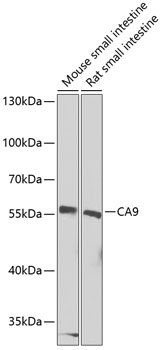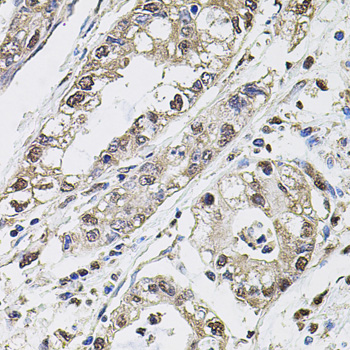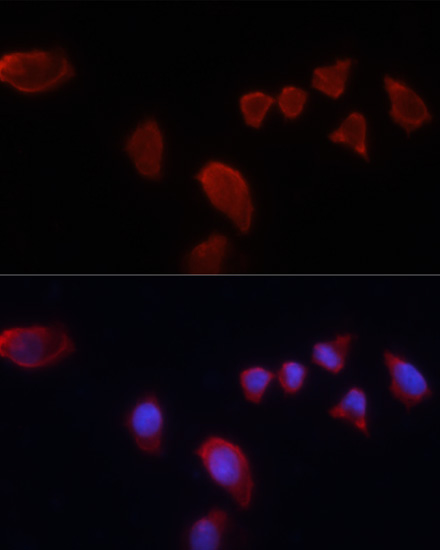Anti-CA9 Antibody (CAB13682)
- SKU:
- CAB13682
- Product type:
- Antibody
- Reactivity:
- Human
- Reactivity:
- Mouse
- Reactivity:
- Rat
- Host Species:
- Rabbit
- Isotype:
- IgG
- Antibody Type:
- Polyclonal Antibody
- Research Area:
- Cell Biology
Frequently bought together:
Description
| 抗体名: | Anti-CA9 Antibody |
| 抗体コード: | CAB13682 |
| 抗体サイズ: | 20uL, 50uL, 100uL |
| 申し込み: | WB IHC IF |
| 反応性: | Human, Mouse, Rat |
| 宿主種: | Rabbit |
| 免疫原: | Recombinant fusion protein containing a sequence corresponding to amino acids 52-151 of human CA9 (NP_001207.2). |
| 申し込み: | WB IHC IF |
| 推奨希釈: | WB 1:500 - 1:2000 IHC 1:50 - 1:200 IF 1:50 - 1:200 |
| 反応性: | Human, Mouse, Rat |
| ポジティブサンプル: | Mouse small intestine, Rat small intestine |
| 免疫原: | Recombinant fusion protein containing a sequence corresponding to amino acids 52-151 of human CA9 (NP_001207.2). |
| 精製方法: | Affinity purification |
| ストレージバッファ: | Store at -20'C. Avoid freeze / thaw cycles. Buffer: PBS with 0.02% sodium azide, 50% glycerol, pH7.3. |
| アイソタイプ: | IgG |
| 順序: | GSSG EDDP LGEE DLPS EEDS PREE DPPG EEDL PGEE DLPG EEDL PEVK PKSE EEGS LKLE DLPT VEAP GDPQ EPQN NAHR DKEG DDQS HWRY GGDP PWPR |
| 遺伝子ID: | 768 |
| Uniprot: | Q16790 |
| セルラーロケーション: | Cell membrane, Cell projection, Nucleus, Single-pass type I membrane protein, microvillus membrane, nucleolus |
| 計算された分子量: | 49kDa |
| 観察された分子量: | 58kDa |
| 同義語: | CA9, CAIX, MN |
| バックグラウンド: | Carbonic anhydrases (CAs) are a large family of zinc metalloenzymes that catalyze the reversible hydration of carbon dioxide. They participate in a variety of biological processes, including respiration, calcification, acid-base balance, bone resorption, and the formation of aqueous humor, cerebrospinal fluid, saliva, and gastric acid. They show extensive diversity in tissue distribution and in their subcellular localization. CA IX is a transmembrane protein and is one of only two tumor-associated carbonic anhydrase isoenzymes known. It is expressed in all clear-cell renal cell carcinoma, but is not detected in normal kidney or most other normal tissues. It may be involved in cell proliferation and transformation. This gene was mapped to 17q21.2 by fluorescence in situ hybridization, however, radiation hybrid mapping localized it to 9p13-p12. |
| UniProt Protein Function: | CA9: Reversible hydration of carbon dioxide. Participates in pH regulation. May be involved in the control of cell proliferation and transformation. Appears to be a novel specific biomarker for a cervical neoplasia. Forms oligomers linked by disulfide bonds. By hypoxia. Expressed primarily in carcinoma cells lines. Expression is restricted to very few normal tissues and the most abundant expression is found in the epithelial cells of gastric mucosa. Inhibited by coumarins, saccharin, sulfonamide derivatives such as acetazolamide (AZA) and Foscarnet (phosphonoformate trisodium salt). Belongs to the alpha-carbonic anhydrase family. |
| UniProt Protein Details: | Protein type:EC 4.2.1.1; Nucleolus; Membrane protein, integral; Lyase; Energy Metabolism - nitrogen Chromosomal Location of Human Ortholog: 9p13.3 Cellular Component: microvillus membrane; basolateral plasma membrane; integral to membrane; nucleolus; plasma membrane Molecular Function:carbonate dehydratase activity; zinc ion binding Biological Process: response to drug; secretion; bicarbonate transport; morphogenesis of an epithelium; one-carbon compound metabolic process; response to testosterone stimulus |
| NCBI Summary: | Carbonic anhydrases (CAs) are a large family of zinc metalloenzymes that catalyze the reversible hydration of carbon dioxide. They participate in a variety of biological processes, including respiration, calcification, acid-base balance, bone resorption, and the formation of aqueous humor, cerebrospinal fluid, saliva, and gastric acid. They show extensive diversity in tissue distribution and in their subcellular localization. CA IX is a transmembrane protein and the only tumor-associated carbonic anhydrase isoenzyme known. It is expressed in all clear-cell renal cell carcinoma, but is not detected in normal kidney or most other normal tissues. It may be involved in cell proliferation and transformation. This gene was mapped to 17q21.2 by fluorescence in situ hybridization, however, radiation hybrid mapping localized it to 9p13-p12. [provided by RefSeq, Jul 2008] |
| UniProt Code: | Q16790 |
| NCBI GenInfo Identifier: | 83300925 |
| NCBI Gene ID: | 768 |
| NCBI Accession: | Q16790.2 |
| UniProt Secondary Accession: | Q16790,Q5T4R1, |
| UniProt Related Accession: | Q16790 |
| Molecular Weight: | 49,698 Da |
| NCBI Full Name: | Carbonic anhydrase 9 |
| NCBI Synonym Full Names: | carbonic anhydrase IX |
| NCBI Official Symbol: | CA9 |
| NCBI Official Synonym Symbols: | MN; CAIX |
| NCBI Protein Information: | carbonic anhydrase 9; pMW1; CA-IX; P54/58N; OTTHUMP00000022773; membrane antigen MN; carbonic dehydratase; carbonate dehydratase IX; RCC-associated antigen G250; RCC-associated protein G250; renal cell carcinoma-associated antigen G250 |
| UniProt Protein Name: | Carbonic anhydrase 9 |
| UniProt Synonym Protein Names: | Carbonate dehydratase IX; Carbonic anhydrase IX; CA-IX; CAIX; Membrane antigen MN; P54/58N; Renal cell carcinoma-associated antigen G250; RCC-associated antigen G250; pMW1 |
| Protein Family: | Carbonic anhydrase |
| UniProt Gene Name: | CA9 |
| UniProt Entry Name: | CAH9_HUMAN |





